
Joyas de platino y de titanio: ventajas y desventajas
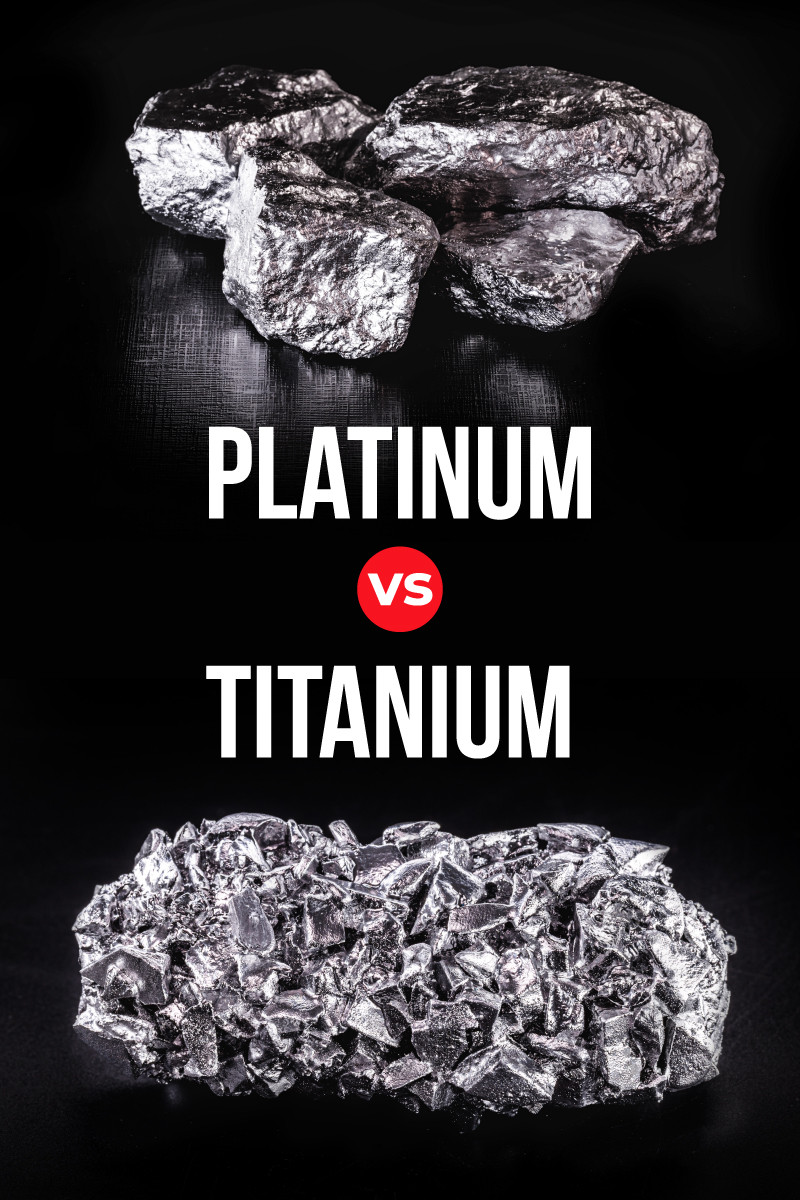 El platino y el titanio son dos metales de moda y duraderos además del conocido oro y la plata , que se han vuelto cada vez más populares para la joyería, particularmente para las alianzas de boda.
El platino y el titanio son dos metales de moda y duraderos además del conocido oro y la plata , que se han vuelto cada vez más populares para la joyería, particularmente para las alianzas de boda.
¿Son mejores los anillos de titanio que los de platino? Bueno, es en gran medida una cuestión de preferencia, ya que ambos tienen una apariencia similar, pero son metales completamente distintos.
Una diferencia importante entre el platino y el titanio es el estatus de cada metal. El platino es uno de los cuatro metales preciosos (junto con el oro, la plata y el paladio), lo que significa que es raro y valioso. Como metal no precioso, el titanio se clasifica como un metal alternativo.
Sin embargo, los metales preciosos no son mejores por naturaleza. Hay muchos factores que se deben tener en cuenta al elegir el metal para sus joyas.
Entonces, ¿cuál es mejor: el titanio o el platino? Eso es lo que responderemos hoy, ya que analizaremos los pros y los contras del titanio frente al platino en función de factores como la resistencia, el precio, la durabilidad y más.
Pero primero, establezcamos algunos conceptos básicos sobre estos dos metales.
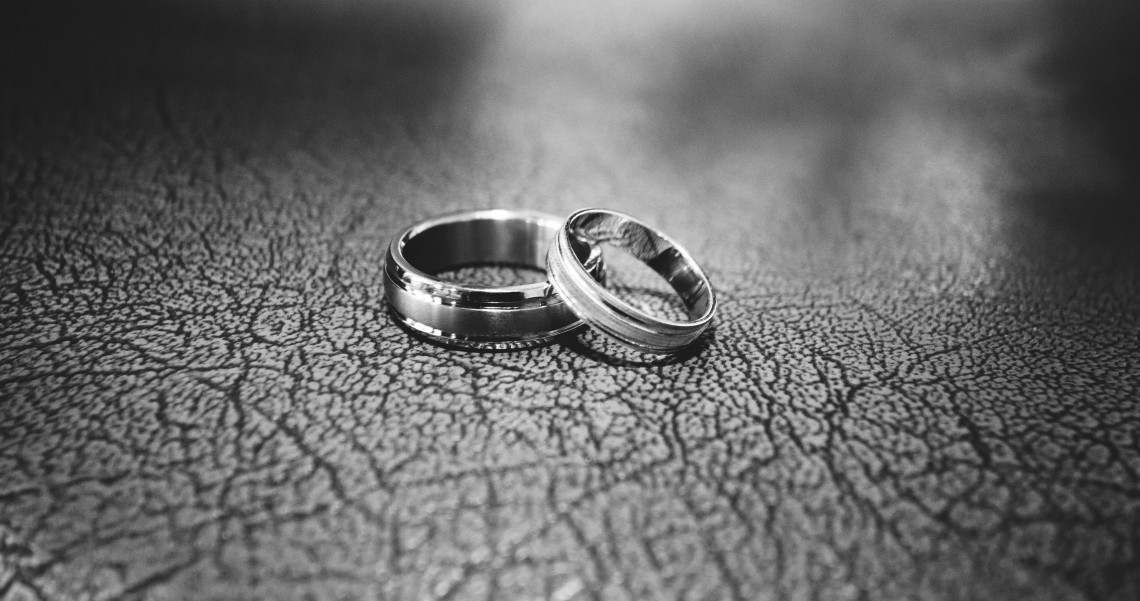
¿Qué son el platino y el titanio?
El platino es un elemento y metal de color blanco plateado. Es conocido por ser muy resistente al deslustre y a la corrosión, además de tener una flexibilidad que lo hace fácil de moldear en diversas formas para joyería. El metal se compara a menudo con el oro blanco por su apariencia blanca brillante similar.
El titanio es un elemento y un metal que solo se encuentra de forma natural en forma de óxido. Es conocido por ser liviano, resistente a la corrosión y por tener la relación resistencia-peso más alta de todos los metales puros: es tan fuerte como el acero, pero apenas un poco más pesado que el aluminio.
Pureza y grados
El platino y el titanio que se utilizan en joyería casi nunca son puros. Los joyeros mezclan otros metales para crear una aleación; este es el caso de la mayoría de los metales para joyería, preciosos o no.
El titanio suele combinarse con aluminio y vanadio. El platino suele combinarse con iridio, cobalto, cobre, paladio o rutenio. La mayoría de los anillos de platino están compuestos por un 90 por ciento de platino y un 10 por ciento de iridio o por un 95 por ciento de platino y un 5 por ciento de rutenio.
Incluso se pueden encontrar aleaciones de titanio y platino, pero esta mezcla es menos común en joyería.
En términos de grados de platino , una clasificación que generalmente indica la composición, pureza y durabilidad de un metal, la mayoría de las joyas de platino son de grado 950, lo que significa que el metal está compuesto de 95 por ciento de platino y 5 por ciento de otros metales.
Los grados de titanio son un poco más complejos.
Grados de titanio
Existen dos categorías generales para los grados de titanio: los grados de aleación de titanio y los grados comercialmente puros (CP). Los grados comercialmente puros se clasifican del 1 al 4, mientras que los grados de aleación de titanio van del 5 al 23.
La mayoría de los joyeros de renombre utilizan grados de titanio comercialmente puros para sus joyas. Estos grados son:
Grado 1 : más suave, más flexible y más fácil de moldear; tiene menos impurezas o metales añadidos; mayor tenacidad al impacto (que explicaremos más adelante) y resistencia a la corrosión.
Grado 2 : Más duro que el Grado 1, casi igualmente resistente a la corrosión, fácil de moldear; Ampliamente disponible, fácil de usar; Buena resistencia al impacto y flexibilidad
Grado 3 : menos utilizado, pero aún valioso; más resistente que el grado 1 o el grado 2, igualmente flexible, menos fácil de moldear.
Grado 4 : más duro y resistente, pero menos flexible; alta resistencia a la corrosión; puede tener el mayor contenido de oxígeno y/o hierro de cualquier grado
Dicho esto, gran parte de las joyas de titanio son de grado 5, también llamado titanio Ti 6Al-4V. Este grado está compuesto aproximadamente por un 90 % de titanio, un 6 % de aluminio, un 4 % de vanadio, un 0,25 % de hierro y un 0,2 % de oxígeno. El titanio de grado 5 es bastante resistente, pero más caro y más difícil de trabajar.
Otro grado de titanio que se utiliza a menudo para las perforaciones corporales es el llamado titanio de “grado aeronáutico”, que mezcla aluminio y vanadio, a veces también con estaño. Este tipo tiene un color más blanco y es tres veces más resistente que cualquiera de los grados comercialmente puros mencionados anteriormente.
Con los conceptos básicos cubiertos, comenzaremos nuestra comparación repasando los factores de compra de joyas de platino.

Pros y contras de las joyas de platino
El platino es un gran metal para joyería con muchas ventajas, como:
Suele tener una pureza mayor que la de otras joyas de metal (por ejemplo, el popular oro de 18 quilates contiene solo un 75 por ciento de oro, en comparación con la mayoría de las joyas de platino, que contienen entre un 90 y un 95 por ciento de platino).
El color mayoritariamente blanco complementa prácticamente cualquier piedra preciosa o adorno.
Extremadamente resistente al deslustre, la corrosión y la decoloración.
Fácil mantenimiento
Por otro lado, algunas desventajas de las joyas de platino a tener en cuenta incluyen:
Más denso (y por lo tanto más caro por peso) que otros metales, lo que lo convierte en un anillo o artículo de joyería pesado.
Se puede rayar con bastante facilidad.
Raro y más caro que otros metales.
Difícil y costoso de cambiar de tamaño.
Además, el platino es complicado de trabajar, por lo que las joyas de platino pueden implicar costos laborales más elevados desde el principio y en el futuro si necesita repararlas.
Ahora bien, ¿son buenas las joyas de titanio? ¡A continuación responderemos esa pregunta!
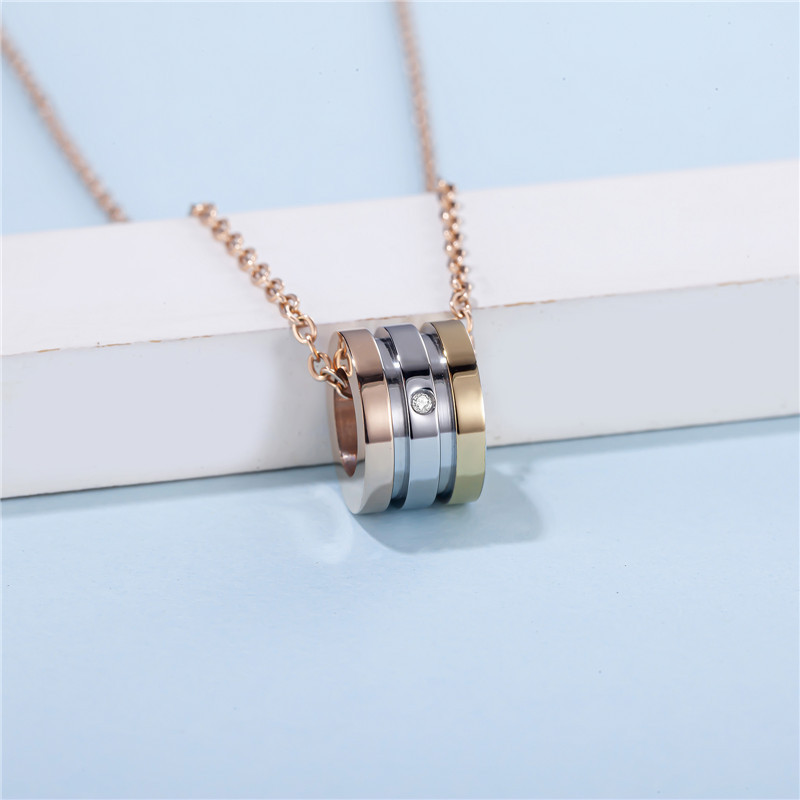
Pros y contras de las joyas de titanio
El titanio es un buen metal para joyería, con ventajas como:
Mayor resistencia al rayado que los metales preciosos.
Más asequible que los metales preciosos
No se agrietará ni se romperá con un impacto fuerte.
Ligero (puede ser una cuestión de preferencia)
Muy resistente a la corrosión y al óxido.
No se desvanecerá con el tiempo.
Hipoalergénico
Colores y acabados versátiles disponibles.
Pero algunas de las desventajas de las joyas de titanio incluyen:
Difícil de cambiar de tamaño
Es difícil agregar configuraciones de puntas tradicionales (a menos que las puntas sean de un metal diferente)
No es tan valioso para la reventa
No tan brillante como otros metales.
Con todos esos pros y contras en mente, es hora de ver cómo se comparan el platino y el titanio entre sí.
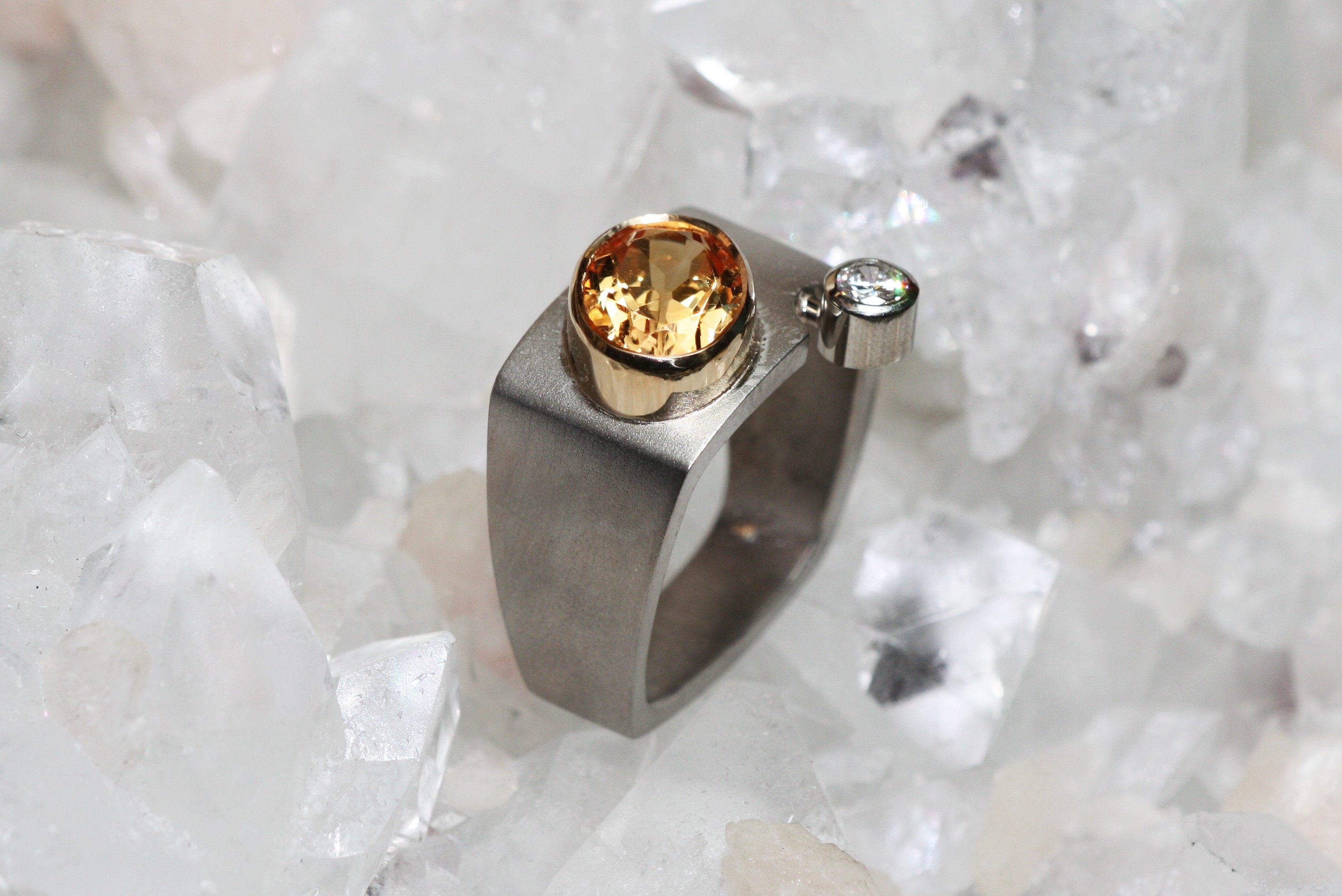 En la imagen de arriba: anillo de platino con diamantes | Crédito de la imagen: VIP jewelry Ltd., Calgary por Dmitri Vtornikov; licencia Creative Commons Attribution-Share Alike 3.0 Unported
En la imagen de arriba: anillo de platino con diamantes | Crédito de la imagen: VIP jewelry Ltd., Calgary por Dmitri Vtornikov; licencia Creative Commons Attribution-Share Alike 3.0 Unported
Comparación entre platino y titanio
Como mencionamos anteriormente, hay muchos factores que influyen en lo que hace que un metal para joyería sea "mejor" que otro. Antes de elegir entre una alianza de boda de platino o de titanio (u otro tipo de joyería), es importante saber cómo se compara cada metal en función de cada factor.
Aspecto del platino frente al titanio
Si analizamos el color del platino frente al del titanio, el platino es de un blanco plateado, mientras que el titanio es de un gris ligeramente más oscuro. Esos son los colores en las formas naturales de los metales. El titanio también tiene una textura algo visible.
Una ventaja del titanio es que los joyeros pueden anodizarlo en distintos colores, como negro, azul, verde, morado e incluso oro rosa.
Por otro lado, el platino no se puede anodizar, por lo que sus colores son más limitados. Dicho esto, los metales anodizados son propensos a rayarse y a perder el color.
Hablando de decoloración, el color del platino no se desvanecerá, pero su brillo se opacará con el tiempo.
En términos de brillo, el platino casi siempre lucirá más brillante que el titanio, a menos que optes por un acabado mate.
Peso del platino frente al titanio
Además de la estética, otra cuestión de preferencia en joyas como los anillos es la sensación que transmiten, es decir, su peso.
A algunas personas les gusta llevar un anillo de bodas más pesado, por ejemplo, como recordatorio de su compromiso. Pero otras pueden tener sensibilidad sensorial o simplemente preferir no sentir el anillo en el dedo. ¡Todo es cuestión de gustos!
El titanio es conocido por ser increíblemente ligero, especialmente por lo resistente que es. Por su parte, el platino es increíblemente denso (aproximadamente un 40 por ciento más denso que el oro), por lo que las joyas de platino parecen bastante pesadas. Si comparamos las densidades de los dos metales, el titanio pesa aproximadamente un tercio del platino.
Para ponerlo en perspectiva, un cubo de platino de 2 pulgadas pesaría poco más de 1,5 libras, mientras que un cubo de titanio de 2 pulgadas pesaría 0,16 libras.
Ahora bien, ¿qué metal es más fuerte: el platino o el titanio?
 En la imagen de arriba: alianzas de boda de titanio
En la imagen de arriba: alianzas de boda de titanio
Resistencia del platino frente al titanio
La resistencia de un metal proviene de algunos factores:
Dureza (resistencia al rayado)
Resistencia a la tracción (cuánto se estirará antes de romperse)
Resistencia al impacto (resistencia a la rotura por un golpe fuerte; una baja resistencia al impacto hace que un material sea “quebradizo”)
En cuanto a la dureza , el platino se encuentra entre 4 y 4,5 en la escala de dureza de Mohs, mientras que el titanio se encuentra entre 6. Esto significa que el titanio es más duro que el platino, por lo que un anillo de platino se rayará más fácilmente que un anillo de titanio. Sin embargo, es más fácil eliminar los rayones del platino que del titanio.
Tenga en cuenta: las aleaciones agregadas al platino o al titanio pueden aumentar la dureza de cualquiera de los metales.
En cuanto a la resistencia a la tracción , el titanio suele superar al platino, pero esto puede depender del grado. El titanio de grado 1 tiene una resistencia a la tracción de 240 a 241 MPa (megapascales), en comparación con la resistencia a la tracción del platino de 120 MPa.
El titanio y el platino tienen una resistencia al impacto comparable: ambos se doblan bajo presión en lugar de agrietarse o romperse.
En resumen, el titanio es generalmente más fuerte que el platino.
Pero ¿es el titanio más caro que el platino?
Precio del platino frente al titanio
El platino es mucho más difícil de conseguir y, por lo tanto, más caro que el titanio. De hecho, el platino es uno de los metales más caros para los anillos de boda.
Si comparamos los precios del titanio con los del platino y el oro, el titanio es considerablemente más barato, mientras que el platino tiene un precio por gramo similar al del oro. Sin embargo, el platino es más denso, lo que significa que se necesita más platino para fabricar un anillo; por lo tanto, costará más que un anillo de oro del mismo tamaño.
Es difícil dar precios exactos, ya que cada minorista y joyero es diferente. Además, se suman costos adicionales por piedras preciosas, adornos, incrustaciones y grabados.
Además, el valor del platino fluctúa con el mercado, al igual que el valor del oro .
Si hablamos del precio de fusión del platino de grado 950 (el valor del metal por sí solo, sin mano de obra ni complementos de venta minorista), actualmente ronda los 32 dólares por gramo o 1.063 dólares por onza troy. En cambio, el precio de fusión del titanio puro es de 0,35 dólares por libra o 0,0008 dólares por gramo.
No importa cuánto gastes, querrás que tus joyas duren. Entonces, ¿cuánto tiempo puedes esperar que duren las joyas de platino y titanio antes de necesitar mantenimiento?
¿Cuánto duran las joyas de platino y titanio?
Tanto el platino como el titanio son altamente resistentes a la corrosión, al deslustre y a la oxidación.
¿Cuánto duran las joyas de titanio? En la mayoría de los casos, ¡toda la vida! Los joyeros de confianza también ofrecen una garantía de por vida. Sin embargo, el titanio de menor calidad puede no durar tanto, por lo que es importante elegir joyas de titanio de alta calidad desde el principio.
¿Cuánto duran las joyas de platino? ¡Toda la vida! Aunque empezará a adquirir pátina y a presentar pequeños arañazos. Por suerte, los arañazos en el platino solo deformarán el metal, no lo desgastarán (gracias a la maleabilidad del platino). Además, muchos compradores aprecian el aspecto del platino envejecido.
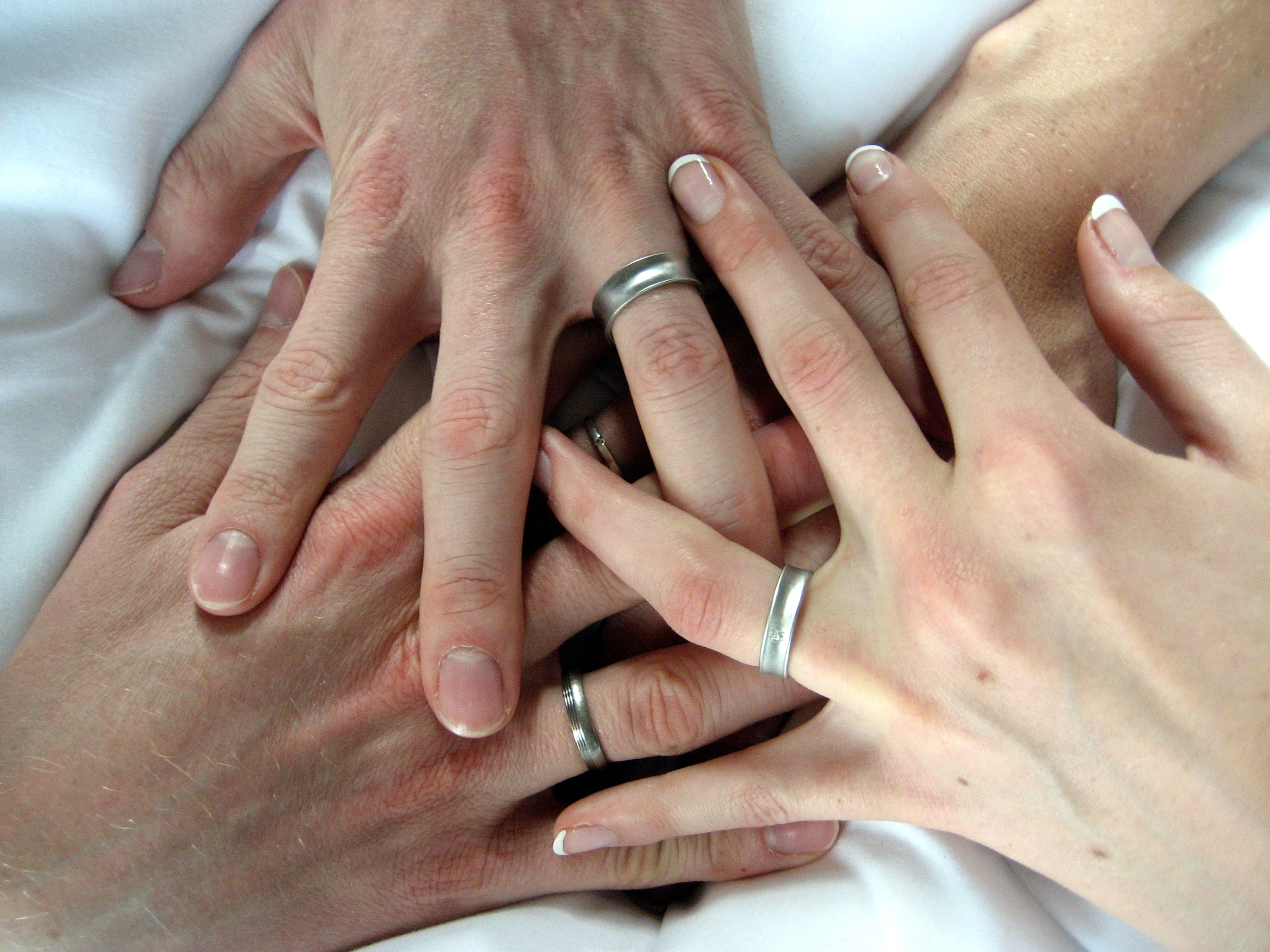 En la imagen de arriba: alianza de titanio (izquierda) y alianza de oro blanco (derecha) | Crédito de la imagen: Abulic Monkey de Birmingham, Reino Unido; licencia Creative Commons Attribution 2.0 Generic
En la imagen de arriba: alianza de titanio (izquierda) y alianza de oro blanco (derecha) | Crédito de la imagen: Abulic Monkey de Birmingham, Reino Unido; licencia Creative Commons Attribution 2.0 Generic
¿Son las joyas de platino o titanio adecuadas para usted?
El platino y el titanio tienen mucho en común: ambos son resistentes, hipoalergénicos, de apariencia similar y se adaptan bien a prácticamente cualquier piedra preciosa. Si busca resistencia a un precio asequible, el titanio es el metal para joyería ideal para usted. Si busca un brillo más blanco y brillante con un valor superior, el platino es el metal ideal para usted.
Independientemente de cuál elijas, ¡ambos resistirán el deslustre y lucirán increíbles!
¿Listo para comprar? ¡Explora nuestra colección de joyas de alta calidad!
Buscar en el Fashion Encyclopedia
Subastas relacionadas
Artículos relacionados
Cómo comprar joyas en Internet. Hay muchos tipos de cuentas. Depende de usted decidir por dónde quiere empezar, si todas son cuentas de piedras preciosas auténticas o si también utilizará cuentas de vidrio "artificiales" y también cuentas de oro y plata.
10th Apr 2019
Cómo comprar un rubí para su anillo o colgante. Asegúrese de aprender todo lo que pueda sobre los rubíes antes de comprar un anillo o un engaste al que vaya a agregar rubíes. Al igual que los diamantes, los rubíes pueden tener defectos e imperfecciones. El rubí es uno de los más
10th Apr 2019
últimos artículos
El titanio es un metal muy utilizado en joyería, conocido por ser ligero, duradero y asequible. Conozca todo sobre el titanio, cómo se compara con otros metales similares y las ventajas y desventajas de las joyas de titanio.
7th Feb 2023
Aprenda todo sobre las joyas de tungsteno: desde su historia y usos hasta su durabilidad y cuidado. Al final de nuestra guía, sabrá si el tungsteno es adecuado para usted.
7th Feb 2023
¿Estás pensando en añadir joyas de oro blanco atemporales a tu colección de accesorios elegantes? ¡Aquí tienes todo lo que necesitas saber sobre el sofisticado oro blanco!
29th Jan 2023




